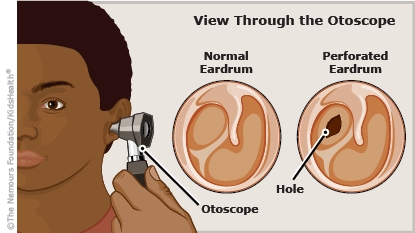A perforated eardrum is a tear or hole in the ear's tympanic membrane (the eardrum). This can happen from an ear infection or from an injury. Usually, the hole closes on its own in a few weeks and hearing returns to normal. Take care of the ear and go to all follow-up visits to make sure the eardrum heals well.



Your child has:

How long does it take for a perforated eardrum to heal? In most cases, the hole closes on its own and hearing returns to normal within several months. Sometimes, surgery is needed to repair a hole that hasn't healed.
How does a perforated eardrum affect hearing? The eardrum is a thin piece of skin-like tissue that's stretched tight — like a drum — across the opening between the ear canal and the middle ear. When sound enters the ear, it vibrates the eardrum. Then, in the middle and inner ear, the vibrations change to signals that the brain senses as sounds. A ruptured eardrum can't vibrate as well as it should. This can cause a hearing problem, which often is temporary.